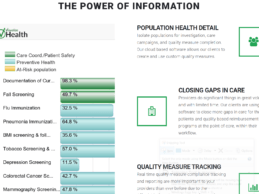In the face of COVID-19, healthcare witnessed how crises can become the long-awaited push for creativity and innovation that the industry needs. When our healthcare infrastructure’s weaknesses were exposed, telehealth helped to stitch them up, with the number of telehealth claims increasing 8,336% nationally from April 2019 to April 2020. Out of need, patients quickly turned to telehealth as a new model of care delivery; clinicians adapted to a new avenue for engaging with patients, policymakers
Read More
healthcare spending
Provider Strategies for Mitigating Telehealth Fraud & Abuse in 2021
As healthcare spending continues to rise, so too does the inherent risk for bad actors to take advantage. Today, the United States is estimated to spend nearly 18 percent of its GDP, or $3.6 trillion, on healthcare, and is expected to increase to one-fifth of GDP within the next decade, according to the latest data. This alone provides ample motivation for fraud and abuse. While the full extent of healthcare fraud is difficult to measure,
The National Health Care Anti-Fraud Association
Read More
Hospital Sustainability Demands that Revenue Integrity Move Front and Center
Razor-thin operational margins coupled with substantial and ongoing losses related to COVID-19 are culminating in a perfect storm of bottom-line issues for U.S. hospitals and health systems. A study commissioned by the American Hospital Association (AHA) found that the median hospital margin overall was just 3.5% pre-pandemic, and projected margins will stay in the red for at least half of the nation’s hospitals for the remainder of 2020.
The reality is that an increase in
Read More
The Future of Patient Access: From Appointment Reminders to Automated Patient Journeys
The concept of 'Patient Access' has evolved significantly. We all remember the good old days when patient access was an inbound responsive model – patients dialed into a call center phone number and were connected "round-robin" to the next available staff member with their call script. Then outbound voice and email messages and patient appointment reminders became common, and now access centers have begun to deploy more advanced communication channels such as natural language voice response,
Read More
4 Ways Healthcare Organizations Can Establish Partnerships to Drive Innovation
With public and private healthcare spending significantly outpacing that of other countries, U.S. hospitals face intense pressure to find new ways to capture greater value. More and more, organizations are finding that partnerships with existing vendors can help unlock next-level performance gains in a transformative environment.
Take Nebraska Medicine, for example. In the early 2000s, the health system created multidisciplinary committees to boost revenue integrity and adopted new revenue
Read More
Why Now’s the Time to Use Connected Health Devices for Diabetes Prevention
It’s no secret that chronic disease remains the leading cause of death worldwide, taking up 90 percent of healthcare spending in the United States. For the last several years, there has been a rise in discussions and research around the promise of connected health devices helping manage and prevent chronic conditions as well as healthcare spending. However, today a number of factors are coming together to make that promise a reality. This includes the improvement of real-world data insights
Read More
Why COVID-19 Underscores The Importance of Social Determinants of Health
Google “Social Determinants of Health” and one will quickly discover a kind of litany of data pointing to a certain definition of “health” defined by the World Health Organization (WHO) as “A state of complete physical, mental and social well-being not merely the absence of disease or infirmity,” and socioeconomic barriers, which may prohibit equitable access to good health and wellness (Healthcare) more completely among diverse populations.
Nevertheless, the heart of the matter
Read More
Sharecare Acquires Value-Based Care Platform Visualize Health
- Sharecare acquires Visualize Health, a Franklin, Tenn.-based population health and quality measure platform that enables payers and providers to close gaps in patient care to maximize value-based care.
- The acquisition will enhance Sharecare’s capabilities for medical records management and is the 14th acquisition since Sharecare was founded in 2010.
Sharecare, the digital health
company that helps people manage all their health in one place, today announced
its acquisition
of
Read More
Analysis: Why Digital Health Investors are Falling in Love with Femtech
Women’s health technology, known as Femtech, is one of the fastest-growing and well-funded categories of digital health. Femtech generally encompasses a range of digital health software and tech-enabled service providers that cater to the specific biological needs of women. These needs span from general health and wellness to reproductive health, including fertility, pregnancy, and nursing care.
Today, reproductive health is the focal point of femtech, thanks in part to the
Read More
4 Digital Health Tools for Combating Opioid Addiction in 2020 & Beyond
The human and economic statistics surrounding the opioid epidemic are staggering. According to the U.S. Department of Health and Human Services, 11.4 million people have misused prescription opioids, and more than 130 people die daily from opioid-related drug overdoses.Moreover, the Society of Actuaries found that the total economic burden of the opioid crisis in the United States from 2015 to 2018 was at least $631 billion. The organization attributed nearly one-third of that cost to extra
Read More










